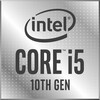Intel Core i5-1030G7 vs Apple M1
Intel Core i5-1030G7
► remove from comparison
The Intel Core i5-1030G7 is a power efficient quad-core SoC for laptops and Ultrabooks based on the Ice -Lake-Y generation that was announced in Mai 2019 (Computex). It integrates four Sunnycove processor cores (8 threads thanks to HyperThreading) clocked at 0.8 (base) - 3.8 (single core Turbo) GHz. All four cores can turbo up to 3.2 GHz using Turbo Boost. According to Intel the Sunnycove cores achieve 18% more IPCs (Instructions per Clock).
The biggest improvement for Ice-Lake is the integrated Gen 11 graphics card called Iris Plus Graphics. The Core i5-1030G7 integrates the biggest G7 variant with 64 CUs clocked at 300 - 1050 MHz. The Iris Plus G7 should be twice as fast as the predecessors and best the AMD Vega 10 GPU in current Ryzen APUs. However, in the Y-series the gaming performance will be again depending on the cooling solution and may degrade clearly over time (compared to the Core i7-1065G7 with 15 - 25 Watt e.g.).
Other improvements for Ice Lake are the AI hardware acceleration and the partial integration of Thunderbolt and WiFi 6 in the chip. The integrated DDR4 memory controller supports modules with up to 3200 MHz (and LPDDDR4 3733).
Performance
While we have not tested a single system built around the 1030G7 as of August 2023, it's safe to expect the chip to be about half as fast as the Core i5-1035G7, as far as multi-thread performance is concerned. Which is fairly poor as of mid 2023.
Your mileage may vary depending on how high the CPU power limits are and how competent the cooling solution of your system is.
Power consumption
This Core i5 has a default TDP (also known as the long-term power limit) of 9 W, a value that laptop manufacturers are allowed to increase just slightly (12 W being the upper limit) resulting in higher clock speeds and higher performance. The processor is built with Intel's 1st gen 10 nm process for OK, as of late 2022, energy efficiency.
Apple M1
► remove from comparison
The Apple M1 is a System on a Chip (SoC) from Apple that is found in the late 2020 MacBook Air, MacBook Pro 13, and Mac Mini. It offers 8 cores divided in four performance cores and four power-efficiency cores. The big cores offer 192 KB instruction cache, 128 KB data cache, and 12 MB shared L2 cache. According to Apple the performance of these cores should be better than anything on the market (in late 2020). The four efficiency cores are a lot smaller and offer only 128 KB instruction cache, 64 KB data cache, and 4 MB shared cache. The efficiency cores (E cluster) clock with 600 - 2064 MHz, the performance cores (P cluster) with 600 - 3204 MHz.
The M1 is available in two TDP variants, a passive cooled 10 Watt variant for the MacBook Air and an active cooled faster variant for the MacBook Pro 13 and Mac Mini. Those should offer a better-sustained performance according to Apple.
The integrated graphics card in the M1 offers 8 cores (7 cores in the entry MacBook Air) and a peak performance of 2.6 teraflops. Apple claims that it is faster than any other iGPU at the time of announcement.
Furthermore, the SoC integrates a fast 16 core neural engine with a peak performance of 11 TOPS (for AI hardware acceleration), a secure enclave (e.g., for encryption), a unified memory architecture, Thunderbolt / USB 4 controller, an ISP, and media de- and encoders.
The Apple M1 includes 16 billion transistors (up from the 10 billion of the A12Z Bionic and therefore double the amount of a Tiger Lake-U chip like the i7-1185G7) and is manufactured in 5nm at TSMC.
| Model | Intel Core i5-1030G7 | Apple M1 | ||||||||||||||||||||||||||||||||
| Codename | Ice Lake-Y | |||||||||||||||||||||||||||||||||
| Series | Intel Ice Lake | Apple M1 | ||||||||||||||||||||||||||||||||
| Series: M1 |
|
| ||||||||||||||||||||||||||||||||
| Clock | 800 - 3500 MHz | 2064 - 3220 MHz | ||||||||||||||||||||||||||||||||
| L1 Cache | 192 KB | 2 MB | ||||||||||||||||||||||||||||||||
| L2 Cache | 2 MB | 16 MB | ||||||||||||||||||||||||||||||||
| L3 Cache | 6 MB | 8 MB | ||||||||||||||||||||||||||||||||
| Cores / Threads | 4 / 8 | 8 / 8 | ||||||||||||||||||||||||||||||||
| TDP | 9 Watt | |||||||||||||||||||||||||||||||||
| Technology | 10 nm | 5 nm | ||||||||||||||||||||||||||||||||
| max. Temp. | 100 °C | |||||||||||||||||||||||||||||||||
| Features | LPDDR4-3733 RAM, PCIe 3, 4 GT/s bus, DL Boost, GNA, MMX, SSE, SSE2, SSE3, SSSE3, SSE4.1, SSE4.2, AVX, AVX2, AVX-512, BMI2, ABM, FMA, ADX, VMX, SMEP, SMAP, EIST, TM1, TM2, HT, Turbo, SST, AES-NI, RDRAND, RDSEED, SHA, SGX | ARMv8 Instruction Set | ||||||||||||||||||||||||||||||||
| iGPU | Intel Iris Plus Graphics G7 (Ice Lake 64 EU) (300 - 1050 MHz) | Apple M1 8-Core GPU | ||||||||||||||||||||||||||||||||
| Architecture | x86 | ARM | ||||||||||||||||||||||||||||||||
| Announced | ||||||||||||||||||||||||||||||||||
| Manufacturer | ark.intel.com | |||||||||||||||||||||||||||||||||
| Transistors | 16000 Million |
Benchmarks
Average Benchmarks Apple M1 → 0% n=0
* Smaller numbers mean a higher performance
1 This benchmark is not used for the average calculation












